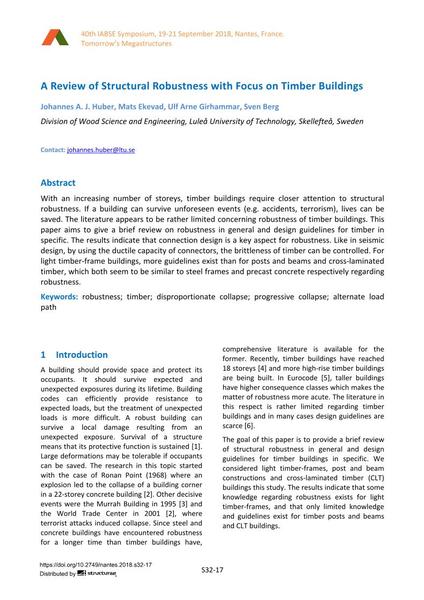A Review of Structural Robustness with Focus on Timber Buildings

|
|
|||||||||||
Détails bibliographiques
| Auteur(s): |
Johannes A. J. Huber
(Division of Wood Science and Engineering, Luleå University of Technology, Skellefteå, Sweden)
Mats Ekevad (Division of Wood Science and Engineering, Luleå University of Technology, Skellefteå, Sweden) Ulf Arne Girhammar (Division of Wood Science and Engineering, Luleå University of Technology, Skellefteå, Sweden) Sven Berg (Division of Wood Science and Engineering, Luleå University of Technology, Skellefteå, Sweden) |
||||
|---|---|---|---|---|---|
| Médium: | papier de conférence | ||||
| Langue(s): | anglais | ||||
| Conférence: | IABSE Symposium: Tomorrow’s Megastructures, Nantes, France, 19-21 September 2018 | ||||
| Publié dans: | IABSE Symposium Nantes 2018 | ||||
|
|||||
| Page(s): | S32-17 | ||||
| Nombre total de pages (du PDF): | 9 | ||||
| DOI: | 10.2749/nantes.2018.s32-17 | ||||
| Abstrait: |
With an increasing number of storeys, timber buildings require closer attention to structural robustness. If a building can survive unforeseen events (e.g. accidents, terrorism), lives can be saved. The literature appears to be rather limited concerning robustness of timber buildings. This paper aims to give a brief review on robustness in general and design guidelines for timber in specific. The results indicate that connection design is a key aspect for robustness. Like in seismic design, by using the ductile capacity of connectors, the brittleness of timber can be controlled. For light timber-frame buildings, more guidelines exist than for posts and beams and cross-laminated timber, which both seem to be similar to steel frames and precast concrete respectively regarding robustness. |
||||
| Mots-clé: |
robustesse
|
||||
